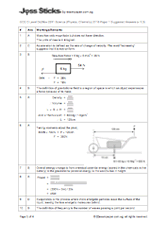For the last time … a last look at the sky, a last glance at the booklet, and a final series of codes:
| Physics Q1-10 | ACBBA ABADB |
| Physics Q11-20 | CBDCD CCADD |
| Chemistry Q21-30 | DBABA BDACC |
| Chemistry Q31-40 | DCCDA DBBAC |
Do they tally with yours?
Note: If you are taking Physics/Biology or Chemistry/Biology, the set of Physics/Chemistry MCQs in the relevant section of your paper should be exactly the same.
Update: For the last time …. the list of workings and explanations for each of the answers (where applicable) have been compiled (along with the questions at the end)!
Access here by clicking the ![]() button (if you haven’t yet done so).
button (if you haven’t yet done so).

That’s all folks. Goodbye and enjoy your holidays and FREEDOM!




 Miss Loi is a full-time private tutor in Singapore specializing in O-Level Maths tuition. Her life’s calling is to eradicate the terrifying LMBFH Syndrome off the face of this planet. For over years she has been a savior to countless students …
Miss Loi is a full-time private tutor in Singapore specializing in O-Level Maths tuition. Her life’s calling is to eradicate the terrifying LMBFH Syndrome off the face of this planet. For over years she has been a savior to countless students … 





















11 Comments
曜
日
Can you please upload the Science Biology MCQ answers too? Thanks!
曜
日
Combined Science (Biology) answers pleaseeee.
曜
日
for qus 33 why is the ans not D but C.Magnesium is less reactive as compared to sodium or pottasium
曜
日
@elaine: Yes magnesium is less reactive compared to sodium or potassium but sodium and potassium are not among the four metals (iron, lead, magnesium and zinc) that are used in Q33.
So out of the four metals, magnesium is the most reactive, and will produce the most number of bubbles in the test tube.
曜
日
Why is question 20's answer 'D' , but not 'A' ?
曜
日
@Edwin: Q20 is D because the magnetic field strength will weaken with distance from the wire as depicted by the magnetic field lines moving further apart away from the wire.
We can't have A as we can't have a uniformly strong magnetic field that goes on and on and on ... unless we're talking about the X-Men Magneto (but even then ...) 😛
曜
日
Any idea how the Bell curve is gonna be for Combined science this year?
曜
日
why is question 22 the answer B instead of C ??
曜
日
@ayumu: It may be a wee bit difficult trying to visualize boiling points on a negative temperature scale, but hopefully the following diagram will clear things up:
At −200°C, we are above the boiling points of helium (−269°C) and neon (−246°C), hence they are still gaseous.
At −200°C, we are below the boiling points of argon (−186°C), nitrogen (−196°C) and oxygen (−183°C), hence they are in liquid state.
曜
日
Could you upload the Pure Biology Paper 1 answers as well?
曜
日
@Jamie: i want the bio answers 🙁